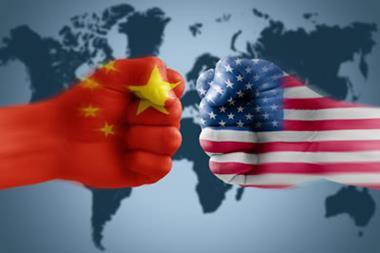The balloon controversies come just as the US and China were attempting to stabilise relations
Seemingly spawned from the opening scene of a sci-fi flick, the shooting down of a mysterious object over the US is instead indicative of fraught real-world geopolitical tensions, experts believe.
When a large white orb was shot down by the US Air Force earlier this month, revelations it was a suspected Chinese spy balloon made for an uneasy new chapter in relations between the world’s top two undisputed superpowers.
While Beijing claims the balloon was only collecting meteorological information and simply drifted into US airspace, the Pentagon suggested this was unlikely as the balloon was controllable and was flown over sensitive areas where nuclear warheads are stored.
Diplomatic drama
“The balloon controversies come just as the US and China were attempting to stabilise relations,” said Andrew Gilholm, principal and director for Greater China and North Asia at Control Risks.
“Presidents Biden and Xi held their long overdue first in-person summit in November, which was relatively constructive in tone. While there was no realistic prospect of reversing the fundamental, negative trajectory of US-China ties, both sides were open to putting ‘guardrails’ – a US term – on the relationship, to mitigate rising risks of escalation on multiple potential trigger issues, especially Taiwan.”
Gilholm said that while the balloon saga is unlikely to permanently derail these efforts, the Biden administration seems to have postponed US Secretary of State Antony Blinken’s China trip reluctantly, due to domestic political pressure rather than a decision to abandon efforts at building talks and guardrails.
“Since November, China has also shown signs of a more conciliatory approach to its troubled foreign relations. However, Beijing is very pessimistic about really repairing ties, and has little confidence that any reconciliation will last beyond the 2024 US elections,” said Gilholm.
“Both sides will seek to manage rather than escalate the balloon issue, and avoid enflaming ties in the coming months as they explore renewed contact. However, this is extremely unlikely to bring any sustainable improvement.”
Gilholm said that the baseline scenario is that US-China and regional relations will continue on a fractious trajectory, vulnerable to periodic crises over multiple potential diplomatic, trade and security trigger points.
Geopolitical competition
Tom Bailey, head of ETF research at HANetf, said the incident is the result of geopolitical competition, with China increasingly focusing on developing its “near-space” capabilities, aimed at integrating forces in outer space and those within the earth’s atmosphere.
“These balloons and potentially other flying objects are part of this [geopolitical competition]. All this points to growing geopolitical competition between China and the US, with control over both the skies and space a core part of this struggle,” said Bailey.
“Therefore, leadership in space technology is increasingly viewed as a strategic priority for both countries. The US refers to advantage in space as ‘the new high ground’. Meanwhile, China has stated its intention to become a ‘space power’.”
Bailey said President Xi Jinping has declared that China’s ‘Space Dream’ is to take the place as the world’s leading space power by 2045.
“This, in turn, should spur on US efforts to maintains it edge and develop space technology. In the US, the space industry is increasingly investable due to NASA projects now relying on partnerships with the private sector,” added Bailey.
Tip of the tensions iceberg
Risk and intelligence firm KCS Group Europe (KCSGE) has warned that suspected Chinese spy balloons are only a minor part in a much broader global espionage war which extends beyond Beijing.
“China is simply attempting to see what works, what it can get away with and what level of pushback there is,” said Stuart Poole-Robb, CEO of KCSGE. “While the Western world deplores China’s latest display of bad altitude, it is as always at ground level where the real threat lies.
“Take the recent news that an Israeli disinformation-for-hire squad, ‘Team Jorge’, has been allegedly used by governments and corporations alike to rig elections, control the narrative and generally manipulate public opinion.
“That’s an operation far more effective, and harder to combat, than sending up a balloon,” said Poole-Robb.
KCSGE states that threats to key infrastructure and assets are not now confined to bombing raids or suicide attacks, but remote cyber hacks and security compromises which have shifted ‘warfare’ to a low-cost, high-efficacy dynamic.
“Most crucially, with the ability of a foe to strike anywhere, anytime, comes the wave of whispering voices reinforcing the idea that they might. Technology has allowed for fake news and propaganda to be elevated into a full-time, global art form,” said Poole-Robb.
Threat (and opportunity?)
For Andrew Chanin, CEO of Procure, the China ‘spy balloon’ situation should serve as both a warning and an opportunity.
“When Russia demonstrated its ability to destroy satellites in orbit utilising missiles in 2021, nations urgently responded by increasing spending on tracking debris in low-Earth-orbit,” said Chanin.
“It would not be surprising to see a ramped up effort to detect and track high-altitude balloons as well as the development of predetermined strategies for handling these potentially harmful breaches upon detection.”
Chanin said further spending on satellites, launch, ground stations and AI/machine learning systems may be required in order to maintain national security in the US and around the globe.
“As we have seen numerous times in the past, when planet Earth is faced with challenges, the space industry has risen to the occasion,” Chanin added.
What next?
Gilholm said that potential Blinken-Wang talks, and any further balloon shoot-downs, revelations or accusations, will indicate whether the saga will be quickly contained and give way to more significant talks, or will escalate, snuffing out diplomatic re-engagement before it begins.
“US House of Representatives Speaker Kevin McCarthy, and another group of US members of congress, are still planning to visit Taiwan this year, but have still not announced any firm plans or dates. This remains a likely trigger for a strong Chinese reaction,” he said.
“Military exercises or FONOPS (Freedom of Navigation Operations) by the US, China and others will be held in the coming months, including around Taiwan, in the South China Sea, and the Korean peninsula. This will sustain security tensions,” added Gilholm.




















No comments yet